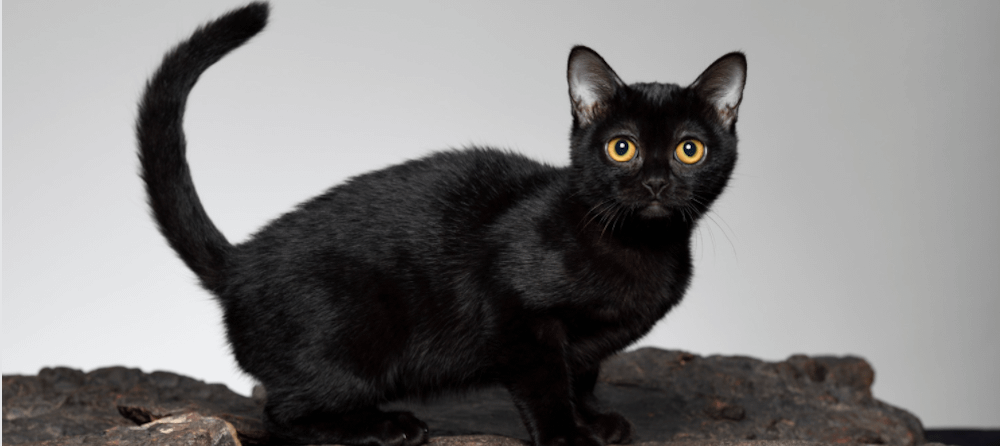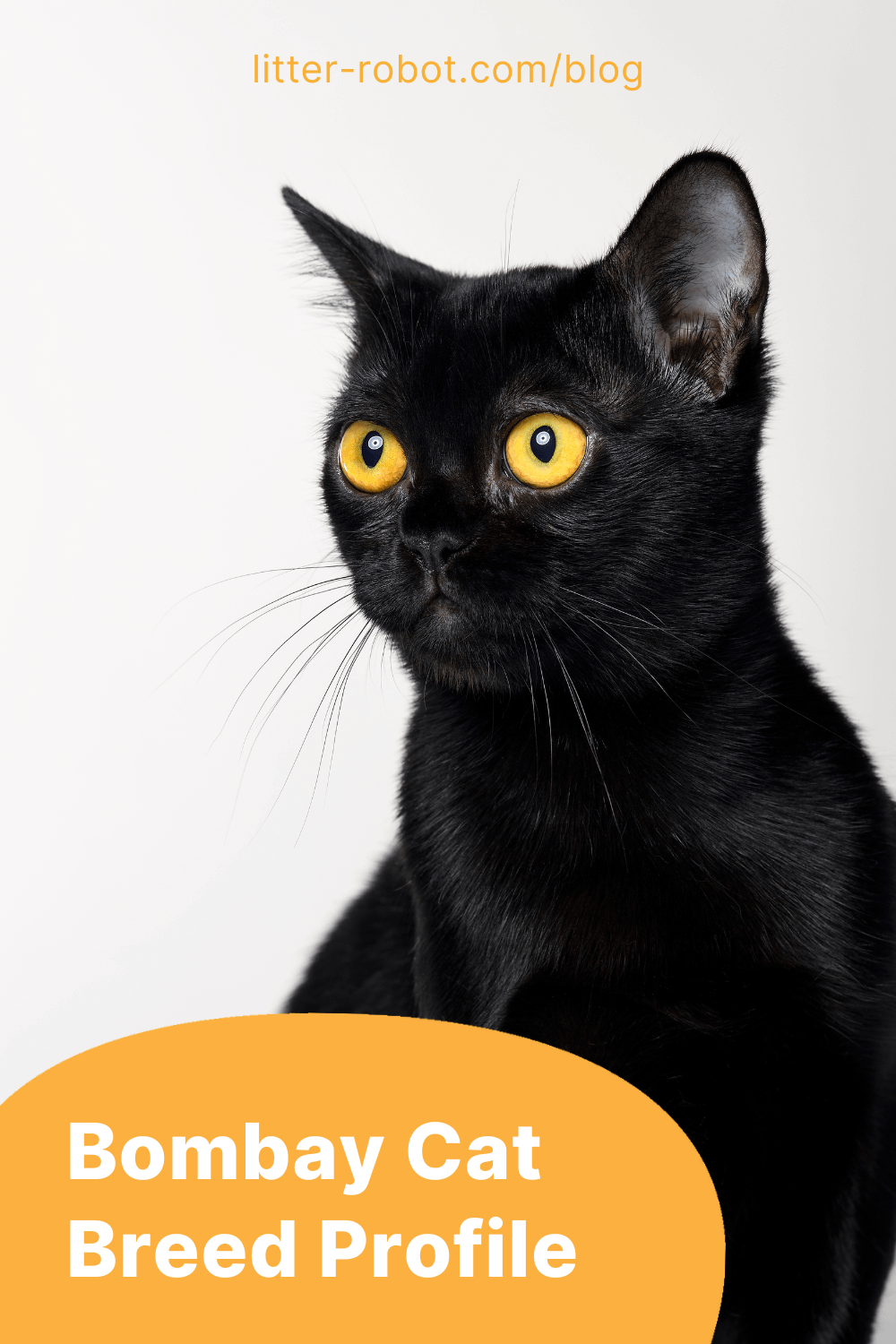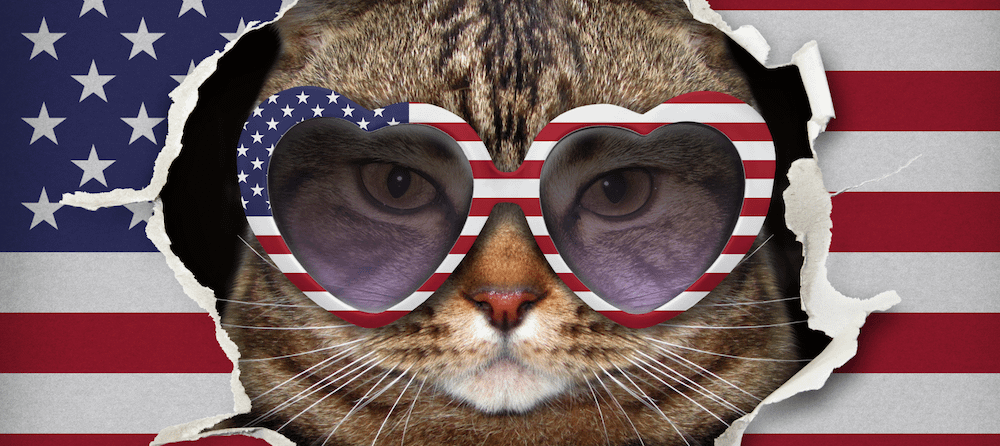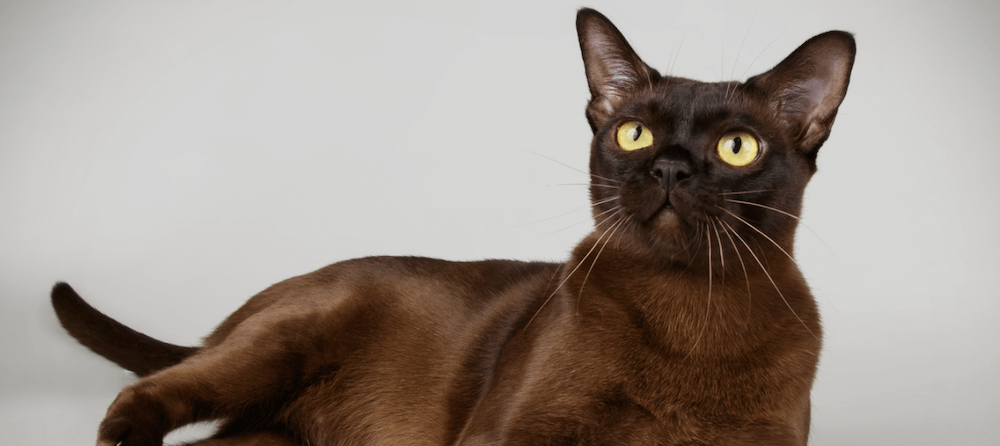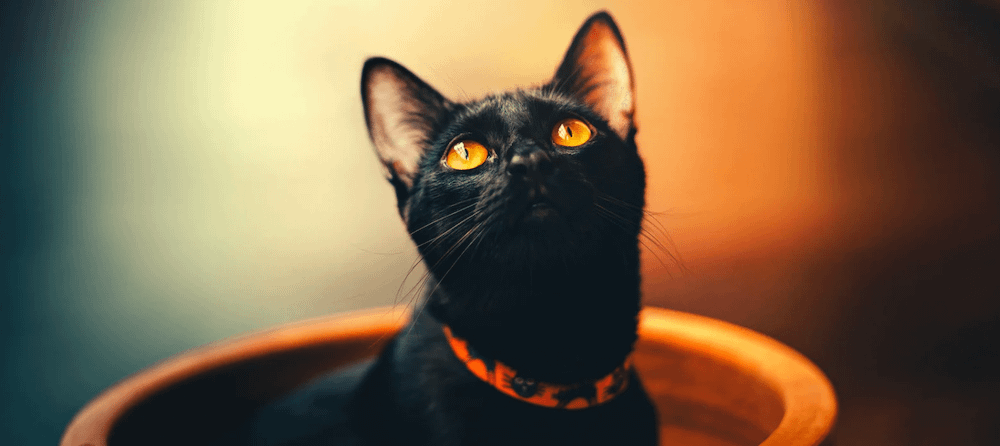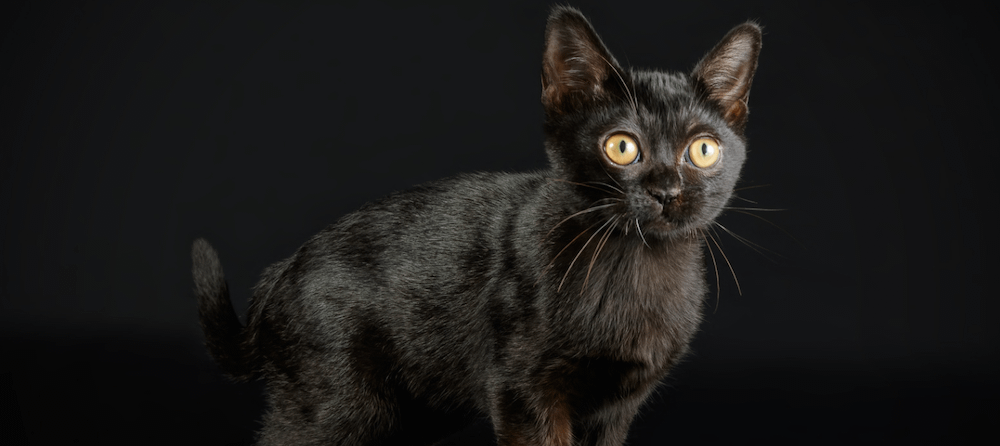Don’t panic: The small, silky black cat with hypnotizing eyes slinking around your house is NOT a panther. Though they seriously resemble one, the Bombay cat is very different from a wild cat. This “parlor panther” is one of the friendliest cats you could encounter!
The Bombay cat is a hybrid breed created when an American Shorthair and Burmese cat mated. These cats are incredibly people-oriented, so if you don’t want a little shadow, the Bombay cat might not be for you. If you crave company as much as these friendly felines do, then you two will get along splendidly.
| Bombay cat | ...at a glance |
|---|---|
| Personality | Friendly, loving, playful |
| Life expectancy | 15-20 years |
| Weight | 6-15 lbs |
| Coat & colors | Short, sleek; black |
| Energy level | Medium |
| Affection level | High |
| Friendliness | High |
| Shedding level | Low |
| Required grooming | Low |
Overview of a Bombay cat
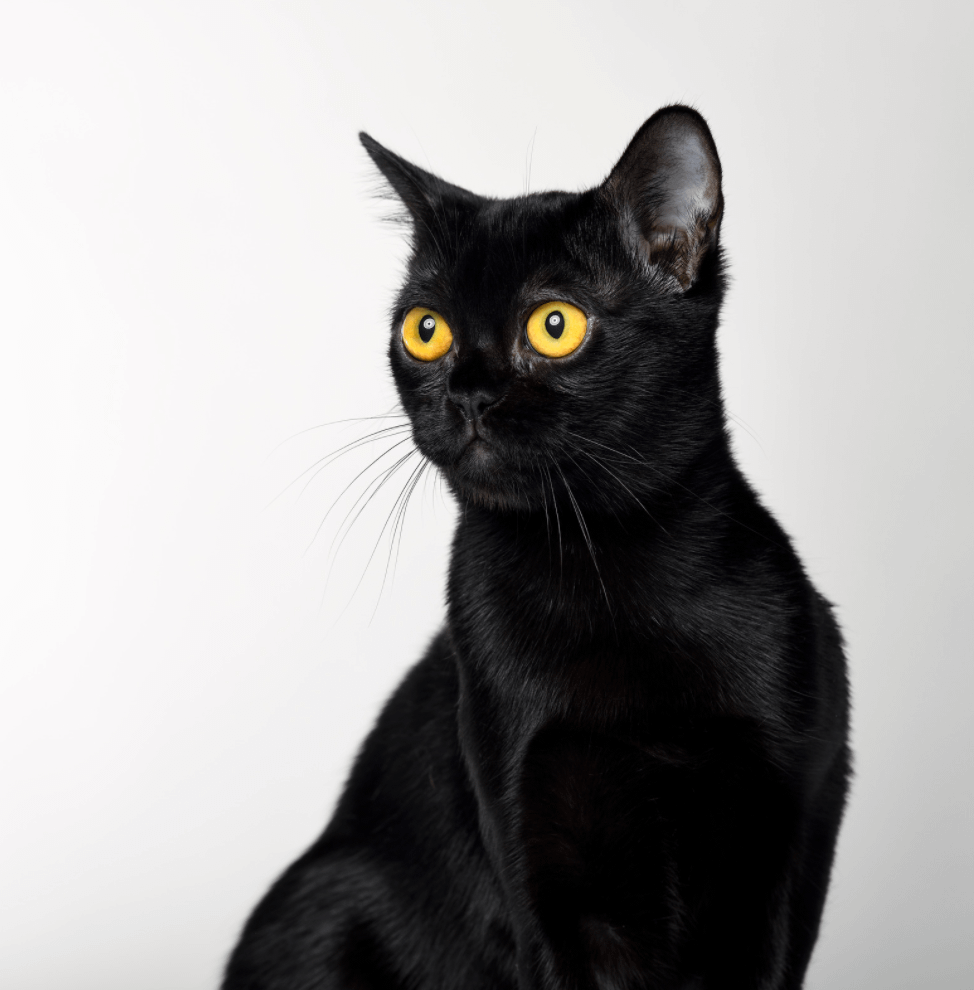
The Bombay cat is considered a medium-sized cat, with strong features and a muscular body that gives them weight you might not anticipate. They are stocky and compact, with round faces and bodies.
Weight
Bombay cats weigh between 6 and 15 pounds. Male Bombays are typically larger than females. Their heavy boning and strong muscles add to their weight, and if they aren’t getting proper nutrition or exercising enough, they can become overweight.
Length
Bombay cats range from 13 to 20 inches long, with their tails similar in length to their torsos. Females might be on the shorter side. The Bombay cat is longer than a Burmese cat.
Coat
The coat of a Bombay stands out among other cat breeds. The Bombay cat is all black, with a sleek and smooth short coat. The fur is very fine and has a satin-like texture that is wonderfully comforting to pet. It shimmers beautifully when the sun hits it just right. (These cats are Instagram-worthy 24/7!)
The Bombay’s coat requires minimal grooming, with weekly brushing to minimize hairballs and shedding. Your Bombay will do most of the heavy lifting when it comes to keeping themselves clean, but your help is appreciated from time to time.
Lifespan
Bombay cats are typically healthy felines. If you are looking for a longtime friend, the Bombay will happily spend 15 to 20 years by your side.
History of the Bombay cat
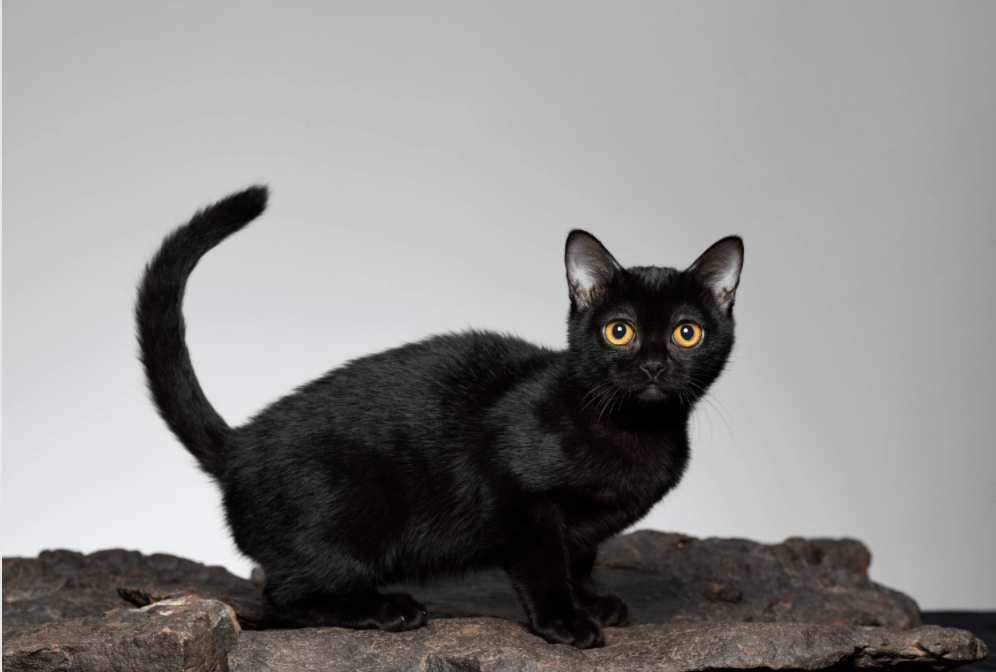
The Bombay cat breed came about in 1958 when Louisville, Kentucky cat breeder Nikki Horner decided she wanted a cat that looked like a Burmese but had a sleek black coat. What she envisioned was essentially a miniature panther that could be domesticated and well-loved.
To do this, she crossed an all-black American Shorthair male with copper eyes with one of her best Burmese cats. After some trial-and-error, careful planning, and dedication, she produced the perfect litter.
These kitties had the body type and short coat of a Burmese, but the yellow eyes and black coloring of an American Domestic Shorthair. Even their paw pads are black.
She named this new cat after the “land of the black leopard”—Bombay, India. The Bombay cats, while beautiful and intriguing, did not gain immediate recognition or acceptance. The Cat Fanciers Association (CFA) didn’t accept them until 1970.
These cats aren’t as popular in the UK or United States as some other breeds, but they still have a devout following of feline fanatics who understand their greatness. The American Bombay breed standard is different from the British Bombay. The American standard calls for a cat with copper eyes (often called “new penny eyes”), while the British standard has green eyes.
If you are lucky enough to come across a Bombay cat, you might be left wondering why they aren’t more popular as pets—considering they are extremely loving, intelligent, and playful.
Characteristics
One of the things that most people point out about the Bombay cat is the way they walk. These cats seem to sway from side to side, effortless and graceful like some sort of jungle illusion. So not only does this cat look like a panther, but they also move with eerie similarity. (We recommend keeping this cat inside on Halloween—and every day—so as not to scare the trick-or-treaters in your vicinity!)
The Bombay is a very round-looking cat: They have round faces, round ears, round eyes, and even round feet. They are very alert, with their ears always working to hear their surroundings and their eyes large and searching.
Most Bombays have brilliant golden eyes that are stark against their coat. Those eyes might surprise you if you spot them in the darkness.
Personality traits
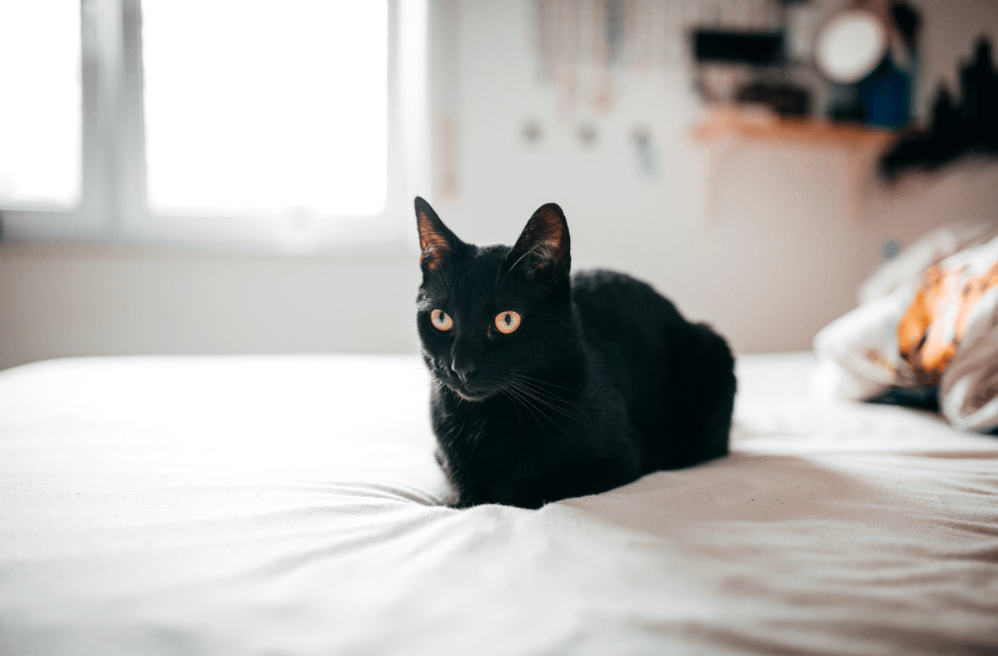
You couldn’t ask for a better kitty! The Bombay is one of the friendliest cats you'll find. They are more than happy to jump up onto your lap and sprawl out, begging for scratches and cuddles.
These cats thrive on attention; you will need to dote on them to keep them feeling happy. The Bombay cat will become withdrawn and anxious when left alone for too long. They do better with another furry friend or staying by your side all day long.
Young Bombays are bursting with energy and would love to play all day if they could. As they grow older, they might choose to retreat to a perch and survey the home.
Once they prefer lounging over lunging, they’ll require more one-on-one cuddles than when they were kittens. Having plenty of toys, scratching posts, and cat trees around can ensure that your Bombay is staying active and intrigued.
Bombays love to watch what is going on around them. If you train them correctly, they will be more than happy to wear a leash and go for a stroll. This will help them expend energy and let their curiosity soar in a safe, controlled environment.
From time to time, you might wake up, startled, to see glowing yellow eyes in complete darkness. No worries, it’s just your Bombay adoringly watching you sleep.
Caring for this breed of cat
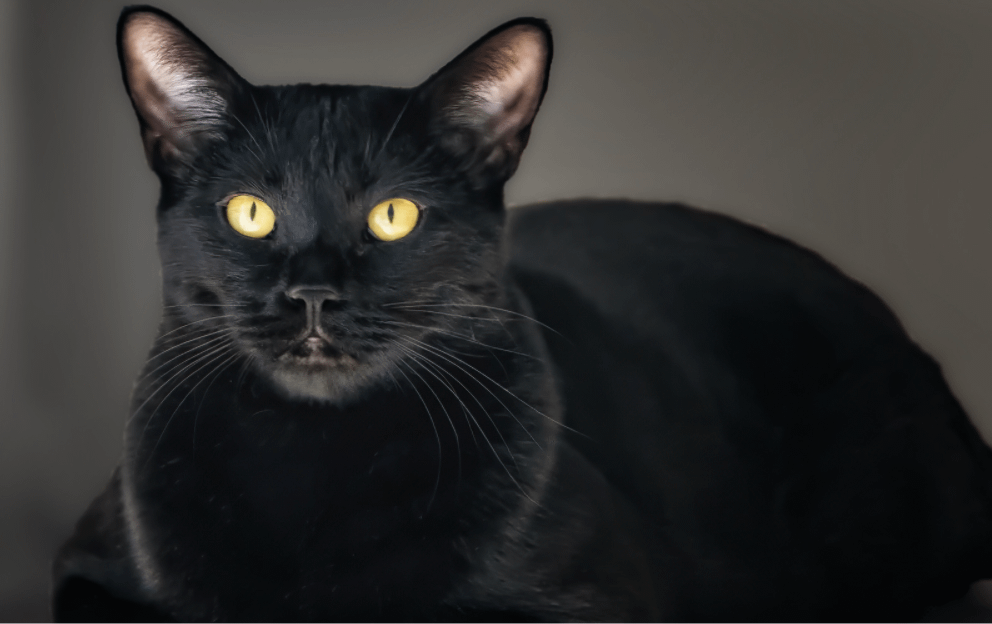
Bombay cats require minimal grooming, especially as they don’t shed too much. Grooming them weekly will help keep up with loose fur (on your cat and your sofa).
The occasional bath will keep their coat in top condition, but they do a very good job at maintaining their sleek look.
You will want to trim their nails every few weeks and keep their ears clean. If your Bombay’s ears look abnormal, reach out to a veterinarian for advice.
Your Bombay should have access to a clean litter box. If you aren’t able (or have no desire) to clean the litter box at least once a day, you should try Litter-Robot. This self-cleaning litter box gives your Bombay a clean bed of litter every time. And because you don’t have to scoop, the litter box experience is more enjoyable for everyone. (It even helps to minimize the smell!)
Possible health issues
Bombay cats are typically healthy cats; with regular vet check-ups, it’s easy to monitor their health. Regardless, certain conditions are more prevalent in some cats, and the Bombay breed is no exception.
Hypertrophic cardiomyopathy is a form of heart disease that causes the muscular walls around the cat’s heart to thicken. As the walls thicken, the blood struggles to circulate through the heart. Talk to your vet about this condition to help ensure that your Bombay kitty stays healthy.
Bombay cats can also experience sinus infections and excessive eye-watering, which causes tearing on the face called epiphora. Wiping your cat's face can help avoid staining.
FYI: This cat loves their food, so keep an eye on potential obesity.
Adopting a Bombay cat
Bombay cats aren’t a breed that you come across every day or even every few months! This breed is somewhat rare, which makes them all the more enticing. Who doesn’t want a tiny panther snuggling up next to you and purring from your affection?
Bombay cats require lots of attention, so be prepared to become your Bombay's favorite person. They will absolutely return your commitment with unprecedented amounts of love.
Sources:
